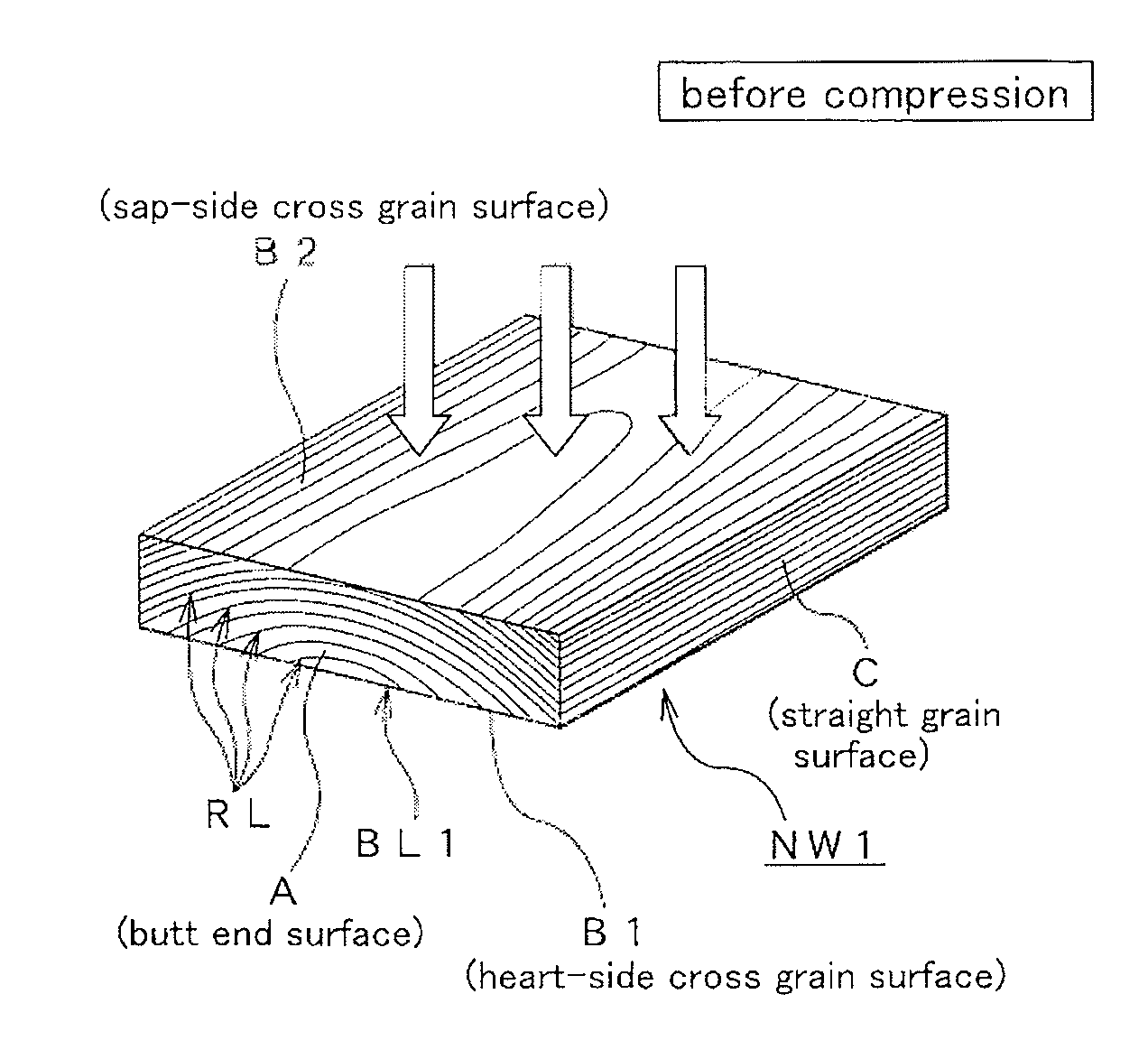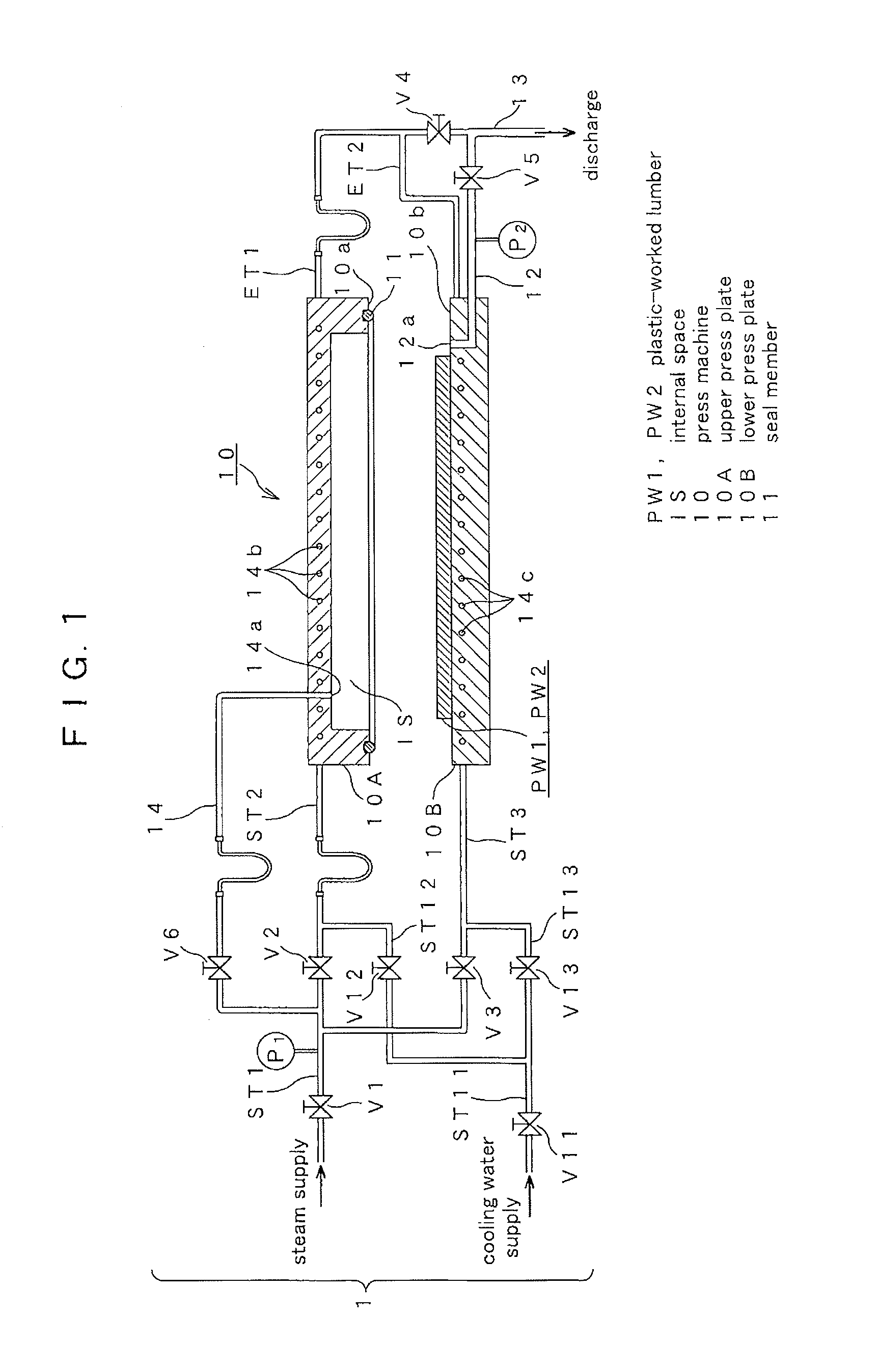[0021]According to the first aspect of the invention, the plastic-worked lumber is formed by applying external force to lumber so as to make a thickness thereof heated and compressed and make the lumber plastically worked. The lumber after heating and compression is arranged so as to have air-dried
specific gravity twice or more than that of the lumber before heating and compression and acute crossing angles within a range of 45 degrees or less. The acute crossing angles are formed by all of annual ring lines on a butt end surface of plastic-worked lumber and imaginary borderlines drawn in a range of 2 mm or less of a
pith-side cross grain surface or a
pith-side straight grain surface as viewed from the butt end surface of the plastic-worked lumber, namely all of annual ring lines on a butt end surface of the lumber after heating and compression and a heart-side cross grain surface or a pith-side straight grain surface of the lumber after heating and compression.
[0022]Therefore, lumber is compressed entirely in a thickness direction thereof and plastically worked so that the lumber has acute crossing angles within a range of 45 degrees or less. The acute crossing angles are formed by all of annual ring lines on a butt end surface of the plastic-worked lumber and imaginary borderlines drawn along a pith-side cross grain surface or a pith-side straight grain surface as viewed from the butt end surface of the plastic-worked lumber, namely all of annual ring lines pm a butt end surface of the lumber after heating and compression and a heart-side cross grain surface or a pith-side straight grain surface of the lumber after heating and compression. Therefore, the lumber is compressed entirely in a thickness direction thereof and plastically worked and has acute crossing angles of 45 degrees or less formed by all of annual ring lines on a butt end surface of the lumber and imaginary borderlines between a pith-side cross grain surface or a pith-side straight grain surface as viewed from the butt end surface of the lumber. That is, acute crossing angles formed by all of annual ring lines on a butt end surface of the lumber after heating and compression and s heart-side cross grain surface or a pith-side straight grain surface of the lumber after heating and compression are within a range of 45 degrees or less. Therefore, almost all cells of an early wood portion are deformed due to compression and
porosity (in
cell cavities) is significantly lowered. The lumber is compressed almost uniformly in overall thickness and physically stable. Thereby, the lumber has reduced variation in quality among products. Moreover, as described above, the lumber is compressed almost uniformly in overall thickness and variation in dimensional change rate inside the product due to a change in ambient conditions after production. Thereby, the lumber has no deformation due to a change in ambient conditions after production. In addition, almost all cells in the early wood portion are deformed due to compression and
cell walls overlap one another. Moreover, the early wood portion has a significantly lowered
porosity in a
cell cavity, thereby increasing a proportion of a late wood portion. Therefore, the plastic-worked lumber after heating and compression tends not to have a flaw or a dent.
[0023]Especially, the plastic-worked lumber is formed so as to have acute crossing angles within a range of 45 degrees or less. The acute crossing angles are formed by all of annual ring lines on a butt end surface of the plastic-worked lumber and imaginary borderlines drawn along a pith-side cross grain surface or a pith-side straight grain surface as viewed from the butt end surface of the lumber. Moreover, the plastic-worked lumber is prevented from having a bending deformation of annual ring lines due to heating and compression, thereby having no crack and the like. Therefore, a high quality of products may be ensured.
[0024]In addition, when a material for the plastic-worked lumber is compressed so as to have a
specific gravity of 0.85 or more, the plastic-worked lumber becomes physically stable and has a reduced variation in quality among products. Moreover, when the specific gravity of the material for the plastic-worked lumber is raised to 1.05, the plastic-worked lumber has a significant increase in
surface strength and stiffness such that it is hardly damaged by a stiletto
heel and may have a higher dimensional stability.
[0025]According to the second aspect of the invention, a process for manufacturing the plastic-worked lumber comprises the step of applying heating and compression to lumber in a thickness direction thereof so that the lumber is heated and compressed and plastically worked. A
resultant plastic-worked lumber is formed so as to have air-dried specific gravity twice or more than that of the lumber before heating and compression and acute crossing angles within a range of 45 degrees or less. The acute crossing angles are formed by all of annual ring lines on a butt end surface of the plastic-worked lumber and a heart-side cross grain surface or a pith-side straight grain surface of the plastic-worked lumber.
[0026]Therefore, lumber is compressed entirely in a thickness direction thereof and plastically worked so that the lumber has acute crossing angles within a range of 45 degrees or less. The acute crossing angles are formed by all of annual ring lines on a butt end surface of the plastic-worked lumber and imaginary borderlines drawn along the pith-side cross grain surface or the pith-side straight grain surface as viewed from the butt end surface of the plastic-worked lumber. Therefore, almost all cells in an early wood portion of the lumber are heated and compressed and
porosity (in cell cavities) is significantly lowered. Thereby, the lumber is compressed almost uniformly in overall thickness and is physically stable, thereby having a reduced variation in quality among products. In addition, as described above, the lumber is compressed almost uniformly in overall thickness and has a reduced variation in dimensional change rate in products due to a change in ambient conditions after production. Therefore, the plastic-worked lumber has no deformation due to the change in ambient conditions after production. In addition, in the plastic-worked lumber, almost all cells of the early wood portion are deformed due to compression and cell walls overlap one another with a significant low porosity in the cell cavities. Then, a proportion of a late wood portion increases. Therefore, the plastic-worked lumber tends not to have a flaw or a dent.
 Login to View More
Login to View More 


